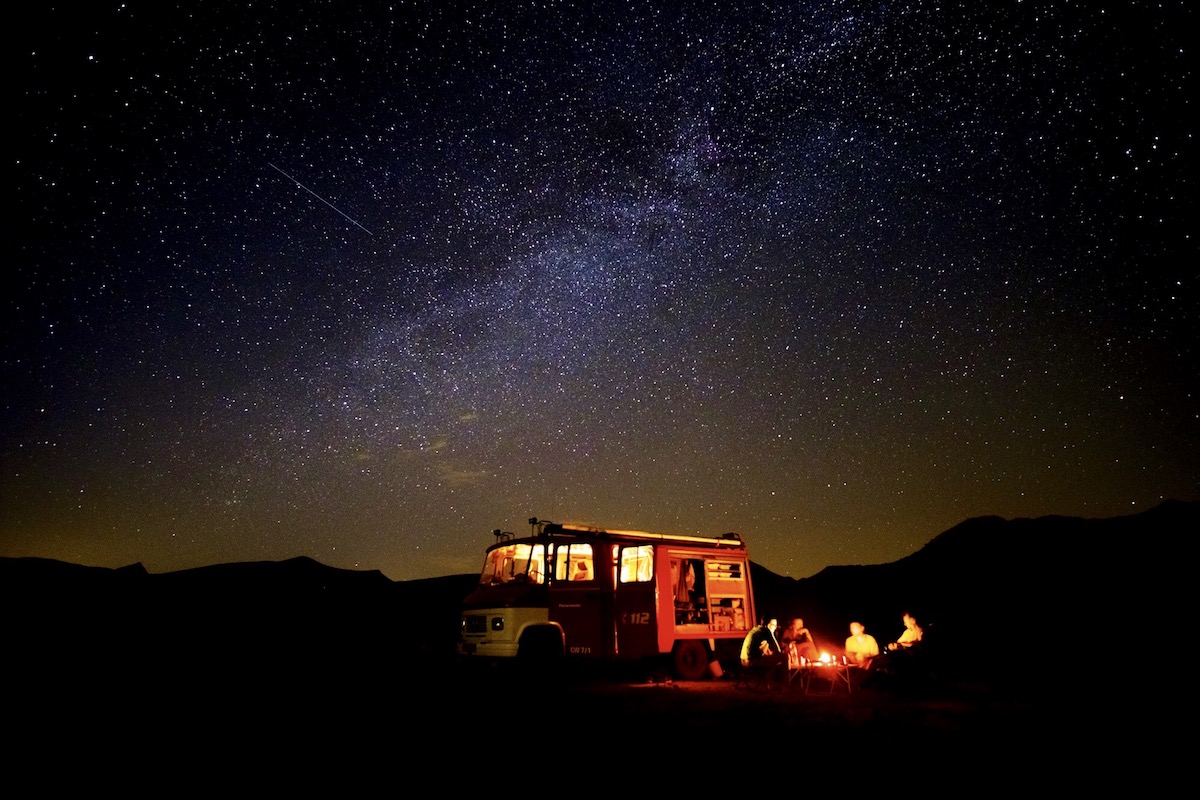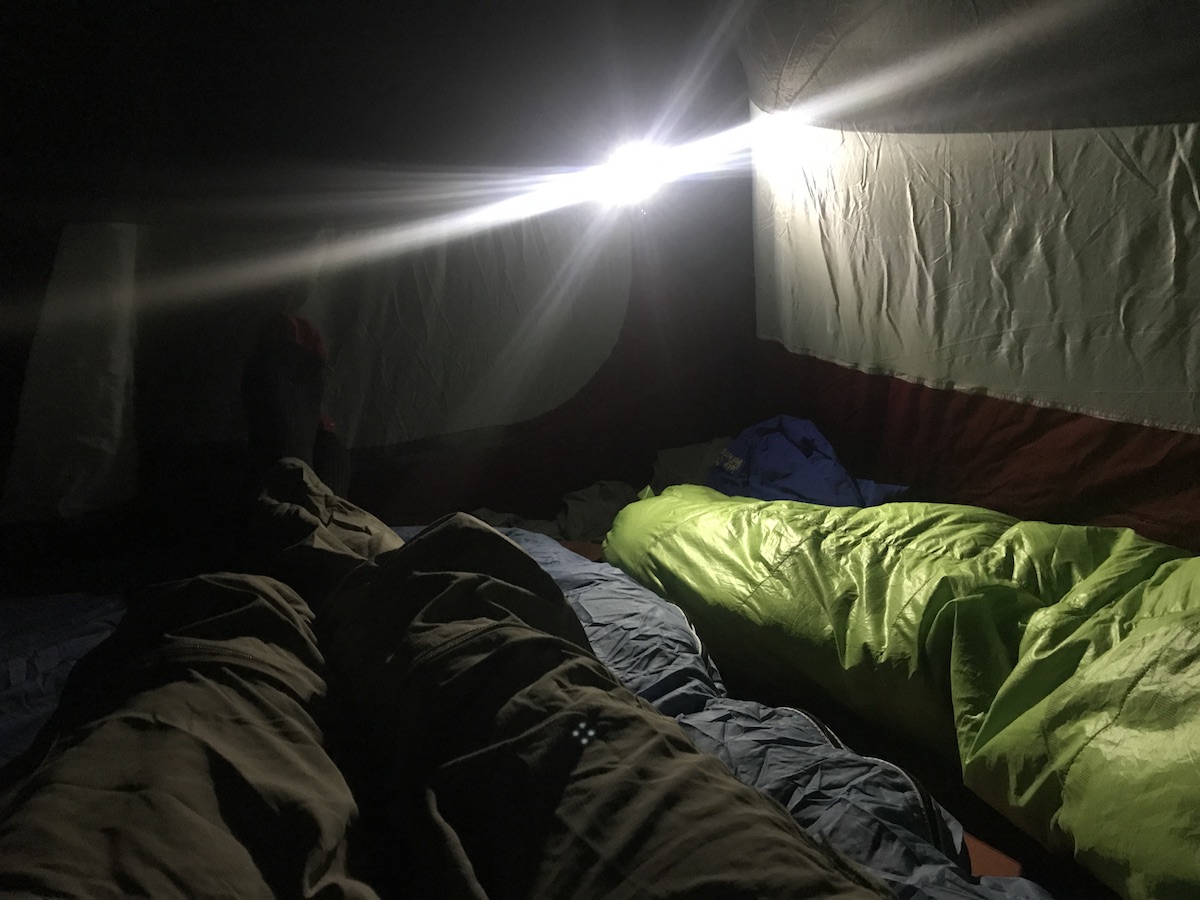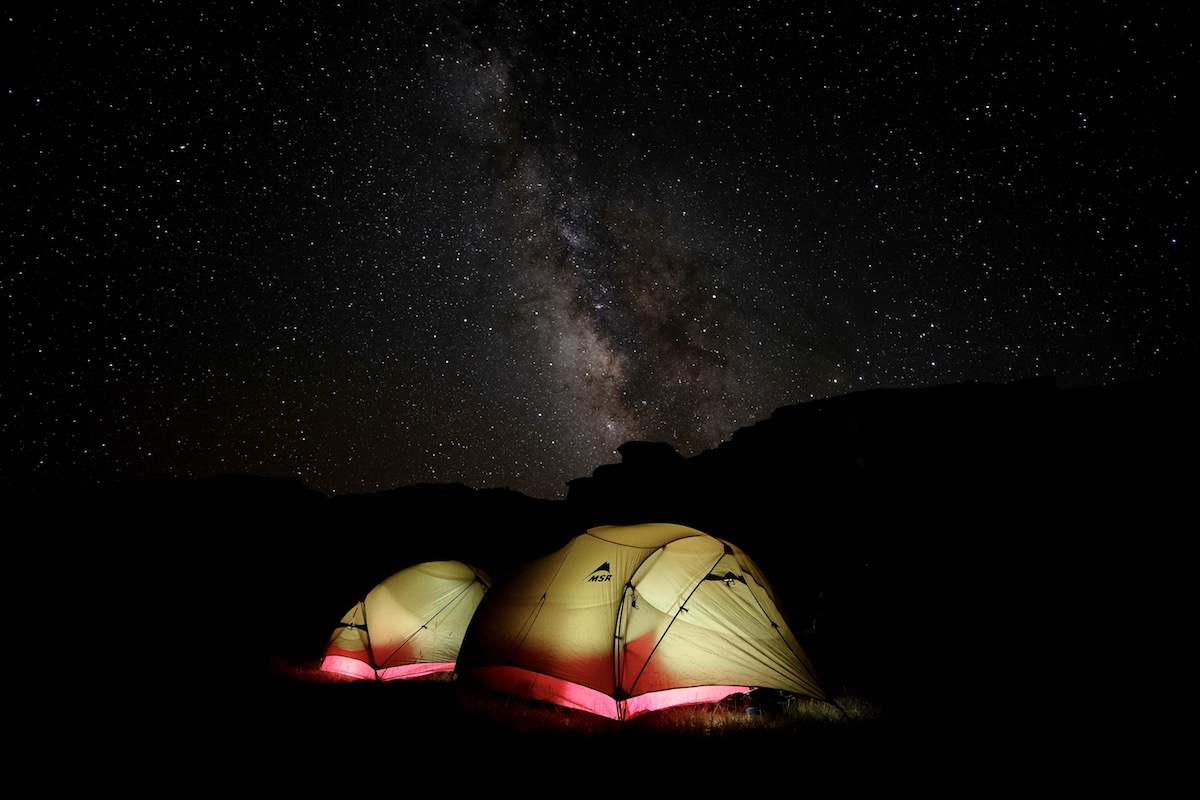Un des premiers prérequis, qui est autant commun à la photo qu’au timelapse, est de bien choisir l’endroit et le moment. Selon les critères d’Hello Bike World, les conditions à remplir sont les suivantes :
- Aucune pollution lumineuse à proximité (ville, routes, etc…)
- Un temps assurément dégagé (pas de nuage ni de brume)
- Un air dépollué, ce qui assure une visibilité maximale
- Dans le cas d’une présence d’un lac, vent minimum afin de profiter d’un beau reflet
- Pas de lune
- Une sacrée dose de motivation pour s’extirper de la tente dans le froid

EXEMPLE DE POLLUTION LUMINEUSE À L’HORIZON
Appareil photo
Si souvent il est de coutume de considérer que ce n’est pas l’appareil mais le photographe qui fait une bonne photo, il y a dans le cas des photos de nuit un minimum matériel requis. Un smartphone ne saura pas répondre à ce genre de périlleuse scène, dû à la taille restreinte de son capteur.
A notre sens, il vous faudra donc vous munir d’un appareil doté d’un capteur de minimum 1″ ainsi que d’une optique la plus lumineuse possible. Dans notre cas, l’appareil derrière ces clichés est un Fujifilm XT2 (capteur APS-C) doté d’un objectif fixe 12mm f2.0. Le grand angle est idéal pour une scène type « campement sous la Voie lactée ».

LE FUJIFILM XT2 UTILISÉ POUR NOS PHOTOS D’ÉTOILES (OBJECTIF DIFFÉRENT)
Réglages de l’appareil
La problématique d’une photo de nuit est de devoir travailler avec une luminosité extrêmement faible. Afin de capter une quantité de lumière suffisante, il y a lieu d’utiliser une ouverture du diaphragme maximale, mais également de choisir un temps d’exposition suffisamment long. Pas trop long non plus, au risque de voir les étoiles « s’étirer » (et oui, la terre a une fâcheuse tendance à tourner sur elle-même, ne l’oublions pas !). La formule magique pour déterminer le temps d’exposition maximal avant de voir les étoiles se déformer est la suivante :
Temps d’exposition maximal : 500/(focale équivalente)
Dans notre cas, une focale de 12mm nous donne un équivalent de 18mm en plein format, dû à son crop factor de 1.5x. Ainsi, le temps d’exposition maximal serait de 27 secondes.
Concernant le réglage des ISOs, il se fait en fonction des autres paramètres (ouverture, temps d’exposition) et doit être ajusté pour obtenir une photo suffisamment lumineuse. La plus faible valeur est la meilleure, pour limiter le bruit. Pour notre photo, une valeur de 3200 ISO a suffi.
Afin d’obtenir une image parfaitement nette, nous ne pouvons que recommander d’utiliser le retardateur pour s’assurer de ne pas bouger lors du déclenchement de l’obturateur.
La tente
Afin d’obtenir une photo un peu plus personnalisée qu’une simple Voie lactée, nous recommandons d’ajouter la tente à votre composition d’image. Quelques petits conseils pour réussir cette intégration :
Ne gardez pas votre lampe frontale allumée pendant toute la durée de l’exposition, la tente en apparaîtrait complètement éclatée. Pour une photo de 15 secondes, il n’est pas nécessaire d’allumer la lampe plus d’une seconde (selon la puissance d’éclairage).
Afin d’obtenir une homogénéité sur toute la surface de la toile, balayez toutes les parois avec votre lampe (en moins d’une seconde, c’est sportif !). Ainsi, la tente apparaîtra sous sa plus belle forme, avec la bonne exposition.
Une autre solution est d’utiliser une source lumineuse extrêmement faible, comme sur la photo ci-dessous :

SOIRÉE À LA BOUGIE
Ici, une petite bougie a été placée au milieu du camion, ce qui permet de rendre cette lumière chaude et chaleureuse tout en n’éclatant pas les couleurs grâce à sa faible luminosité.
Timelapse
La première technique de l’allumage-extinction de la frontale en une seconde ne peut pas s’appliquer pour un timelapse, à moins de vraiment vouloir passer la nuit à switcher sa lampe. Il est donc nécessaire de couvrir sa lampe d’un tissu afin d’obtenir un éclairage affaibli. Testez plusieurs emplacements jusqu’à obtenir l’éclairage le plus diffus possible.

EH OUI, IL A FALLU DORMIR AVEC CETTE LUMIÈRE EN PLEINE FACE !
Une fois que vous êtes satisfait de votre photo, vous pouvez lancer votre intervallomètre pour la nuit et observer le résultat le lendemain:
Un détail final peut vous causer une mauvaise surprise au réveil : la durée de la batterie.
Batterie
Si la plupart des appareils-photos réflexes tiennent largement la route niveau batterie, d’autres ne peuvent pas tenir toute la nuit en shootant sans arrêt. D’autre part, les appareils photo ne peuvent pas forcément se charger en fonctionnement, il est nécessaire de les éteindre pour pouvoir recharger la batterie (surtout via USB). Alors, comment faire ?
Encore une fois, Hello Bike World est là pour vous ! Voilà notre astuce (les chiffres dépendent de votre modèle d’appareil) :
- Branchez votre appareil à une batterie externe, que vous attacherez soigneusement à votre trépied.
- Sélectionnez une mise en veille programmée à 45 secondes après déclenchement.
- Optez pour un intervalle d’une minute (minimum) entre chaque photo pour votre timelapse.
- Laissez la magie opérer !
Explications: En choisissant un intervalle plus grand que le temps de mise en veille, l’appareil aura le temps de s’éteindre entre chaque prise de vue. Une fois l’appareil photo en veille, la recharge s’opère, jusqu’à ce que l’appareil sorte de veille, en l’occurrence 15 secondes plus tard. Ce cycle suffit largement à garder la batterie a un niveau de charge stable, et donc de tenir la nuit complète, malgré les 600 clichés que demande un timelapse de 20 secondes.
Retouches logicielles
Une fois votre photo importée sur votre ordinateur, libérez votre créativité pour faire ressortir les étoiles ou votre sujet (ex: tente) selon vos préférences. Dans notre cas, une augmentation de la luminosité du ciel ainsi qu’une retouche légère des couleurs a permis de rendre plus d’éclat à la photo.

PHOTO AVANT RETOUCHE

PHOTO APRÈS RETOUCHE
Et voilà ! C’est (presque) aussi simple que cela ! Vous avez à présent les outils techniques, à vous de briller par une composition d’image originale et poétique !


4 Comments on “Tutoriel : photos et timelapse d’étoiles”
Très bon article. Merci ! Je me réjouis d’essayer lors de ma prochaine session camping.
Super reportage du montage photos étoiles… Magnifiques résultats…
J’avais eu la chance de lire cet article en avant-première merci encore
Ge
Je voulais dire technique*.
C’est technologie mais hyper intéressant Firmin ! En tout cas c’est magnifique!